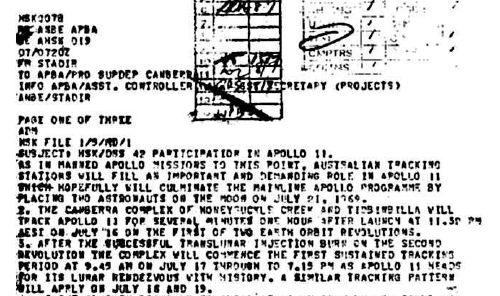A little easier to read, here’s the text of the pre-mission TWX:
Subject: HSK/DSS42 Participation in Apollo 11.
As in manned missions to this point, Australian tracking stations will fill an important and demanding role in Apollo 11 which hopefully will culminate the mainline Apollo Programme by placing two astronauts on the Moon on July 21, 1969.
2. The Canberra complex of Honeysuckle Creek and Tidbinbilla will track Apollo 11 for several minutes one hour after launch at 11.32pm AEST on July 16 on the first of two Earth orbital revolutions.
3. After the successful Translunar Injection burn on the second revolution, the complex will commence the first sustained tracking period at 9.45am on July 17 through to 7.15pm as Apollo 11 heads for its rendezvous with history. A similar tracking pattern will apply on July 18 and 19.
4. As the complex picks up tracking on July 20, Apollo 11 will be in its fourth lunar orbit and will have just commenced the tenth orbit when loss of signal occurs as the Moon dips below the horizon at 10pm.
5. However, similar complexes at Madrid Spain and Goldstone California will maintain communications when Apollo 11 is not visible from Canberra.
6. At acquisition at 11.15am AEST on July 21, the Lunar Module containing astronauts Armstrong and Aldrin should already be on the Moon, having touched down earlier at 6.19am. The Command Module bearing astronaut Collins will be commencing lunar orbit seventeen.
7. During the first stage of this day’s tracking, the astronauts will be engaged in checking out the LM systems and resting prior to the moment at 4.12pm when Man, in the person of astronaut Armstrong, emerges to set foot on the lunar surface. During this period of some two (2) hours forty (40) minutes of lunar surface activity the Canberra complex, joined by their colleagues at the CSIRO 210 ft antenna, Parkes, will be the prime and only links between Mission Control at Houston and the astronauts on and around the Moon.
8. After the astronauts have re-entered the LM, tracking will continue until 11pm, the LM still on the Moon and the Command Module about to commence orbit 23.
9. On re-acquisition at 11.45am AEST on July 22, the three astronauts should be together in the Command Module in orbit no. 29, the LM having earlier lifted off the surface at 3.55am and docked at 7.30am.
10. At 2.37pm, while both the Goldstone and Canberra complexes are jointly tracking, the Service Propulsion Engine will be fired behind the Moon to commence the Trans Earth Coast. Following the successful firing, tracking will continue until 12.08am on July 23.
11. Similar tracking periods will occur from 12.15pm July 23 to 1.15am July 24 and from 12.50pm July 24 to 2.20am July 25, approximately 30 minutes before splashdown in the Pacific at 2.51am Friday July 25, approximately 1100 miles SW of Hawaii and the end of Man’s most momentous journey.
12. During the final period of astronaut lunar surface activity on July 21, black and white television will be received by the Parkes antenna and relayed to Houston. This television will also be received by either Honeysuckle or Tidbinbilla, depending on which is tracking the Lunar Module at that time.
13. One station will track the Command Module as it orbits the Moon: the other will maintain contact with the LM and the astronauts on the surface. Both stations have the capability of tracking either vehicle.
14. All personnel involved are looking forward to supporting this giant step in space exploration by maintaining tracking and communications throughout the flight of Apollo 11. |
